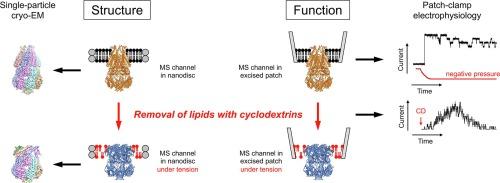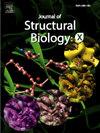Cyclodextrins for structural and functional studies of mechanosensitive channels
Abstract
Mechanosensitive (MS) channels that are activated by the ‘force-from-lipids’ (FFL) principle rest in the membrane in a closed state but open a transmembrane pore in response to changes in the transmembrane pressure profile. The molecular implementations of the FFL principle vary widely between different MS channel families. The function of MS channels is often studied by patch-clamp electrophysiology, in which mechanical force or amphipathic molecules are used to activate the channels. Structural studies of MS channels in states other than the closed resting state typically relied on the use of mutant channels. Cyclodextrins (CDs) were recently introduced as a relatively easy and convenient approach to generate membrane tension. The principle is that CDs chelate hydrophobic molecules and can remove lipids from membranes, thus forcing the remaining lipids to cover more surface area and creating tension for membrane proteins residing in the membranes. CDs can be used to study the structure of MS channels in a membrane under tension by using single-particle cryo-electron microscopy to image the channels in nanodiscs after incubation with CDs as well as to characterize the function of MS channels by using patch-clamp electrophysiology to record the effect of CDs on channels inserted into membrane patches excised from proteoliposomes. Importantly, because incubation of membrane patches with CDs results in the activation of MscL, an MS channel that opens only shortly before membrane rupture, CD-mediated lipid removal appears to generate sufficient force to open most if not all types of MS channels that follow the FFL principle.


 求助内容:
求助内容: 应助结果提醒方式:
应助结果提醒方式:


